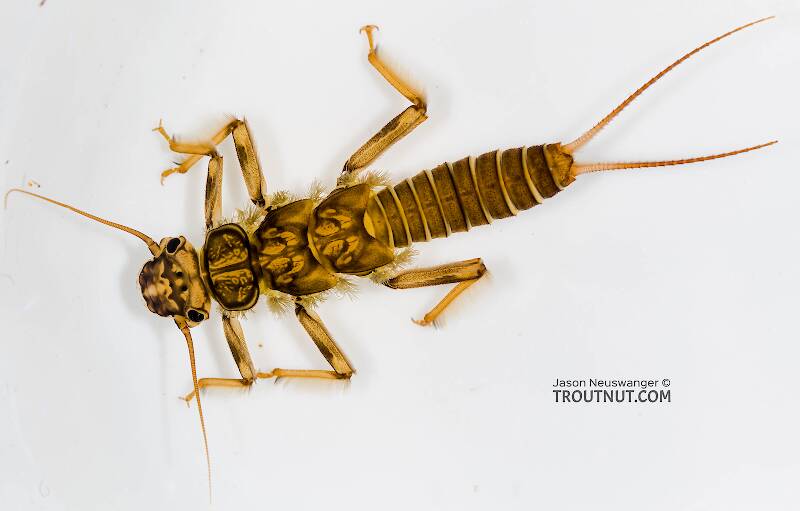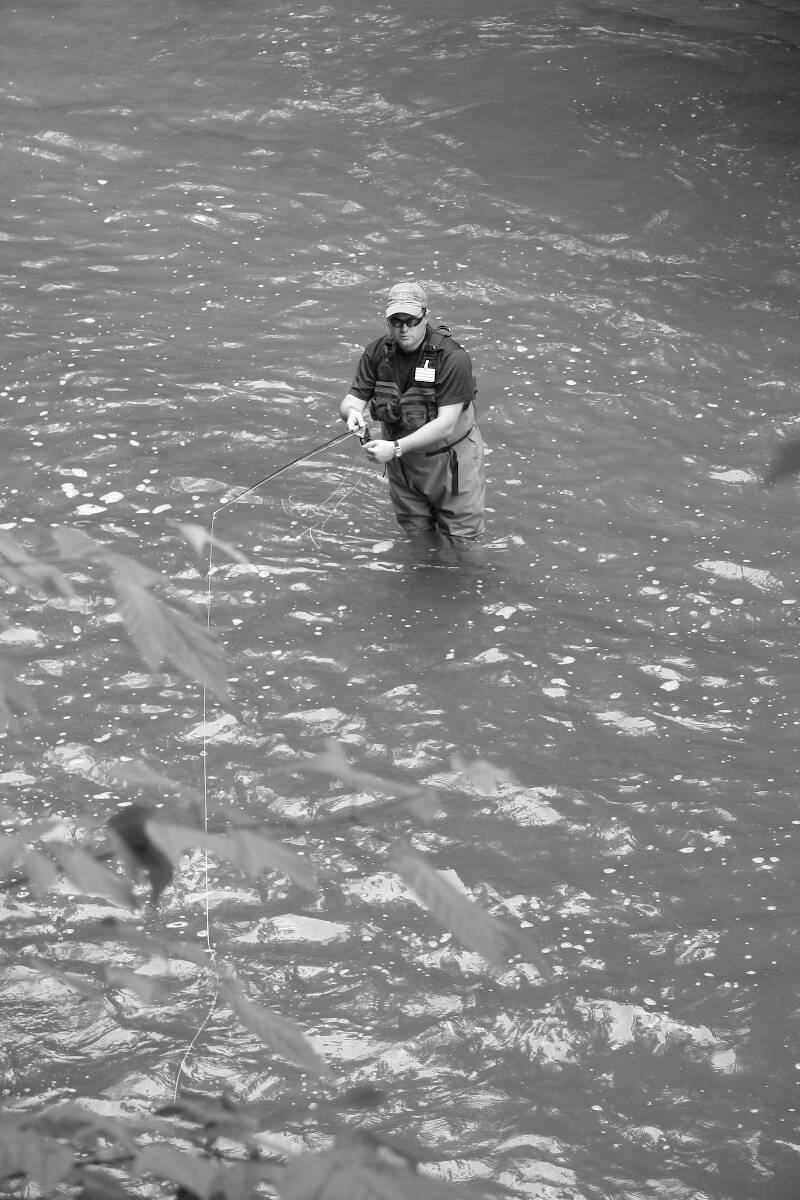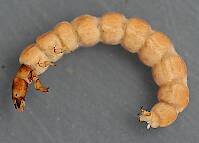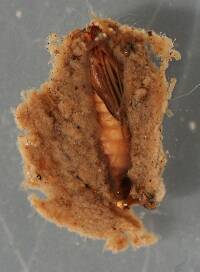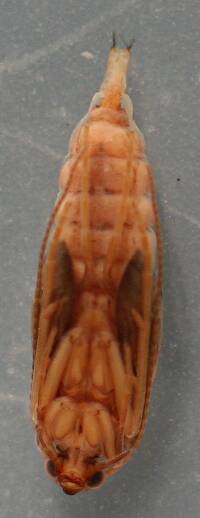
Hex Mayflies
Hexagenia limbata
The famous nocturnal Hex hatch of the Midwest (and a few other lucky locations) stirs to the surface mythically large brown trout that only touch streamers for the rest of the year.
Featured on the forum

Troutnut is a project started in 2003 by salmonid ecologist Jason "Troutnut" Neuswanger to help anglers and
fly tyers unabashedly embrace the entomological side of the sport. Learn more about Troutnut or
support the project for an enhanced experience here.
Flatstick96 on Jul 19, 2009July 19th, 2009, 3:03 pm EDT
Louis, those are three excellent techniques, all of which I use fairly often (the first two more than the third).
The first week I lived in State College I ran into John Stoyanoff on Spring Creek; we chatted and fished for awhile, during which time I got hung up on a rock. He showed me what you referred to as the "harp string" technique (I think he called it "bowstring"), and I've used that a lot - sometimes it results in a snapped-off fly, but not often.
I've also climbed trees in attempts to retrieve flies; the most memorable was a very large, and VERY thick pine tree. By the time I got done wrestling with that tree I had pine pitch from head to toe...but I got my Lt. Cahill back.
The first week I lived in State College I ran into John Stoyanoff on Spring Creek; we chatted and fished for awhile, during which time I got hung up on a rock. He showed me what you referred to as the "harp string" technique (I think he called it "bowstring"), and I've used that a lot - sometimes it results in a snapped-off fly, but not often.
I've also climbed trees in attempts to retrieve flies; the most memorable was a very large, and VERY thick pine tree. By the time I got done wrestling with that tree I had pine pitch from head to toe...but I got my Lt. Cahill back.
Shawnny3 on Jul 20, 2009July 20th, 2009, 2:36 am EDT
Though I've never broken a rod tip this way.
I have. But I still do it, because I hate so much losing flies.
-Shawn
Jewelry-Quality Artistic Salmon Flies, by Shawn Davis
www.davisflydesigns.com
www.davisflydesigns.com
Martinlf on Jul 20, 2009July 20th, 2009, 8:29 am EDT
Duane, John is the guy who showed me the harp string method!
Shawn, I know what you mean.
Shawn, I know what you mean.
"He spread them a yard and a half. 'And every one that got away is this big.'"
--Fred Chappell
--Fred Chappell
Flatstick96 on Jul 20, 2009July 20th, 2009, 12:08 pm EDT
HA! Small world indeed...
Shawnny3 on Jul 20, 2009July 20th, 2009, 12:47 pm EDT
Listen to you little bowstring disciples harping on.
When hung up on rocks, I use a multi-step system.
First, I try to see exactly where my fly is hung up. That way, if I snap it off on later steps, I still have a chance of finding it. I also try to remember to inspect my surroundings to make sure that my actions will not cause the fly to rocket off the obstruction and into a branch 20 feet above my head.
I use the roll cast method as long as the fly is far from me and is not very far underwater. If the fly is above water on a rock, this technique almost always works. If the fly is underwater, it rarely works.
For underwater rocks my first technique is to jerk smartly on the line from various angles. Duane is amazed how few times I snap off flies when I do this, because I am pretty aggressive. Changing the angle is key and is easier to do if the rock is close to me. I try to screw up as little water as possible if I happen to have to approach the fly to change the angle. This might mean backing out of a spot and walking up the bank a little way before giving some more smart jerks on the line.
If none of these work, I use a technique I developed for myself that I find very useful when hooked on (or worse, under) a submerged rock. First I wade right up to the rock. I get one foot planted solidly so that I don't fall in when I try the next part of "the move." Holding my line tight, I slide my other foot down my leader between the leader and the rock. When my foot nears the streambed, the angle on the line changes very dramatically, and this almost always frees the fly. This move can be used on deep snags in fast water - anywhere you can stand without taking a swim. It has salvaged me many a fly.
This has become quite a thread - all the experts in futility are gathering...
-Shawn
P.S. That's just what I do when hung up on rocks. I have a Treatise on the Removal of Flies from Branches which will have to wait for another time.
When hung up on rocks, I use a multi-step system.
First, I try to see exactly where my fly is hung up. That way, if I snap it off on later steps, I still have a chance of finding it. I also try to remember to inspect my surroundings to make sure that my actions will not cause the fly to rocket off the obstruction and into a branch 20 feet above my head.
I use the roll cast method as long as the fly is far from me and is not very far underwater. If the fly is above water on a rock, this technique almost always works. If the fly is underwater, it rarely works.
For underwater rocks my first technique is to jerk smartly on the line from various angles. Duane is amazed how few times I snap off flies when I do this, because I am pretty aggressive. Changing the angle is key and is easier to do if the rock is close to me. I try to screw up as little water as possible if I happen to have to approach the fly to change the angle. This might mean backing out of a spot and walking up the bank a little way before giving some more smart jerks on the line.
If none of these work, I use a technique I developed for myself that I find very useful when hooked on (or worse, under) a submerged rock. First I wade right up to the rock. I get one foot planted solidly so that I don't fall in when I try the next part of "the move." Holding my line tight, I slide my other foot down my leader between the leader and the rock. When my foot nears the streambed, the angle on the line changes very dramatically, and this almost always frees the fly. This move can be used on deep snags in fast water - anywhere you can stand without taking a swim. It has salvaged me many a fly.
This has become quite a thread - all the experts in futility are gathering...
-Shawn
P.S. That's just what I do when hung up on rocks. I have a Treatise on the Removal of Flies from Branches which will have to wait for another time.
Jewelry-Quality Artistic Salmon Flies, by Shawn Davis
www.davisflydesigns.com
www.davisflydesigns.com
Martinlf on Jul 21, 2009July 21st, 2009, 6:35 am EDT
Oh yes, I forgot the foot method. One should note that using this method at times the fly will become embedded in the felt of one's wading shoe, on the shoestrings, etc. Use caution when this happens. Tighten the line enough to keep it from becoming stuck on a nearby rock or other snag then walk to the shore while keeping just enough tension on the line to avoid snapping it and possibly losing the fly.
I'm waiting for Shawn's treatise on removing flies from overhead snags with bated breath.
I'm waiting for Shawn's treatise on removing flies from overhead snags with bated breath.
"He spread them a yard and a half. 'And every one that got away is this big.'"
--Fred Chappell
--Fred Chappell
CaseyP on Jul 21, 2009July 21st, 2009, 7:34 am EDT
not having the balance to walk and chew gum, i use my wading staff to tweak the offending fly from the rock. figured that out one cold February day when reaching in up to my armpit was just not going to happen, "waterproof" cuffs or not.
getting flies out of trees is easier in the winter--no leaves so you can see better, and maybe it doesn't get hung up in the first place. another reason to fish in the winter!
getting flies out of trees is easier in the winter--no leaves so you can see better, and maybe it doesn't get hung up in the first place. another reason to fish in the winter!
"You can observe a lot by watching." Yogi Berra
Shawnny3 on Jul 21, 2009July 21st, 2009, 12:29 pm EDT
As you said, Casey, keeping your arm out of the water is often a good plan, and besides, you have a longer reach with your leg. And since this thread is, after all, about what can go wrong going wrong, it's worth mentioning that leaning forward to retrieve a fly can result in all sorts of things spilling out of your vest. Fortunately, I've never lost a flybox this way, but a lost utility tool and a few canisters of sinkers come to mind. I've also had one of the lenses from my glasses pop out and into the stream, but happily I was in shallow water and was able to retrieve it with my one aided eye.
-Shawn
-Shawn
Jewelry-Quality Artistic Salmon Flies, by Shawn Davis
www.davisflydesigns.com
www.davisflydesigns.com
CaseyP on Jul 21, 2009July 21st, 2009, 3:53 pm EDT
oh, glasses! Best Fishing Buddy and i were on the Ruby in MT, and since it was new water, we were in sight of each other. suddenly he begins shouting and waving --he's dropped his glasses which are all but rimless. the water is nearly knee deep. cobblestone bottom. the glasses fell off his head, so who knows which direction?
first we look very hard into the water, which is thankfully as clear as gin. then i begin to feel around my feet with my hands, working slowly and v-e-r-y carefully towards and around him. after a very long and painstaking 20 minutes, I feel them! hooray! trip is saved: it's his only pair.
now you may encounter on the river a retiree with a Hemingway beard and glasses fishing happily with pieces of old leader securing everything to his person: glasses, hat, car keys...
first we look very hard into the water, which is thankfully as clear as gin. then i begin to feel around my feet with my hands, working slowly and v-e-r-y carefully towards and around him. after a very long and painstaking 20 minutes, I feel them! hooray! trip is saved: it's his only pair.
now you may encounter on the river a retiree with a Hemingway beard and glasses fishing happily with pieces of old leader securing everything to his person: glasses, hat, car keys...
"You can observe a lot by watching." Yogi Berra
Quick Reply
Related Discussions
Topic
Replies
Last Reply
2
Jan 23, 2017
by Mcflyangler
by Mcflyangler
2
Oct 19, 2015
by Wbranch
by Wbranch


